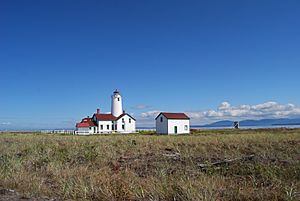Dungeness Spit facts for kids
Dungeness Spit is an amazing natural sandbar. It stretches out about 5 miles (8 kilometers) from the northern edge of the Olympic Peninsula in Clallam County, Washington, USA. This long strip of sand reaches into the Strait of Juan de Fuca. It is actually the longest natural sand spit in the entire United States!
The spit is always growing, getting about 15 feet (4.5 meters) longer each year. The water it surrounds is called Dungeness Bay. Dungeness Spit is part of the Dungeness National Wildlife Refuge. It is also home to the historic New Dungeness Lighthouse.
About Dungeness Spit
Dungeness Spit covers a large area of land. It is about 0.49 square miles (1.27 square kilometers or 314 acres). This special place is open to visitors all year long. You can explore its unique environment and enjoy the views.
The Lighthouse Story
The New Dungeness Lighthouse stands at the very end of the spit. For many years, the United States Coast Guard managed the lighthouse. In 1976, they put in an automatic light system.
However, since 1994, a group of volunteers has taken over. This group is called the "New Dungeness Light Station Association." They work hard to keep the lighthouse running and looking great.
A Bit of History
Europeans first recorded Dungeness Spit in 1790. This was during a Spanish exploration trip led by Juan Carrasco. Later, in 1792, a British explorer named George Vancouver gave the spit its name.
He thought it looked a lot like a place called Dungeness in England. So, he decided to call it "New Dungeness."
A Stormy Challenge
In December 2001, a very strong winter storm hit the area. The storm pushed water right over the spit. The next morning, the spit was actually broken into three parts!
This made it impossible for vehicles to reach the lighthouse for about a month. It shows how powerful nature can be.





